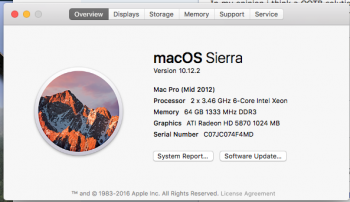thxs for your answer
why not take the X5690 Processor? (of course its more expensiv...)
what do you think about a PCI Express SSD ?
any details about the Nvidia web driver problem?
and at least a bit stupid question: what do you exactly understand with "good native support"
[doublepost=1485211221][/doublepost]
-any recommends for "the fastest RAM possible"??
-agreed
-Raid 1 should be fine, Raid 5 would be the more secure and faster solution or is this wrong?
The price difference between X5690 and X5680 sometimes can be very large (e.g. 50%), and the real world performance difference is almost negligible. If money is not an issue, I will sure go for dual X5690, but that usually not a smart move (unless you can source a pair of cheap X5690).
PCIe SSD is very good, but not a balanced option. It's highly focus on extreme sequential speed, the trade off is smaller storage and much more expensive. Again, if budget is not an issue, I will tell you go for 4x SM951 512GB RAID 0 + Amfeltec card. However, that's not a good option to keep the budget low. IMO, the main point of using SSD is the low latency, not the high sequential speed. And the small files read / write performance (4K random read QD1) on a single SATA SSD (SATA II connection) is almost identical to the 4x SM951 RAID 0 setup. So, why go for the more expensive setup if you don't really need it? Of course, high sequential speed is also a big advantage. But again, do you really need it? I have a 840 Evo, I have a Tempo SSD card (PCIe SATA III card). I tried that setup. TBH, can't feel any difference. My Mac run more or less with the same speed (including video editing) no matter how I connect the 840 Evo. In fact, I can edit 4K Pro Res with HDD only (non RAID). Of course, that will require a very large HDD space. But obviously PCIe SSD is not required, then why go for a more expensive + less storage option if not required. It's my personal experience, that's why I suggest you simply connect a 850 Evo to the lower optical bay to save money. However, that may not fit your workflow, if you are interested in high speed SSD. I will suggest you go straight to the PCIe SSD but not SATA SSD + PCIE SATA III card.
Since I am a FCPX user, I end up gave up the SATA III card and install a 2nd GPU there. Which gives me good performance jump. And obviously it gives me more benefit than a higher speed SSD (only applicable for my usage). Anyway, here is my setup
https://forums.macrumors.com/thread...mac-with-2-d700s.1732849/page-5#post-21722712
About "native support" and Nvidia web driver, please read through this post. (At least post #1)
https://forums.macrumors.com/thread...out-nvidia-pc-non-efi-graphics-cards.1440150/
Any, "native support" means the card can run OOTB. No software or hardware mod required. Just plug that into the PCIe slot, and OSX / macOS will provide a driver to run the card. R9 280X and GTX680 has native support from Apple, but GTX980 do NOT. If you install that card in the Mac and boot, all you have is just black screen. And it may happen on every single OS update (including security update). You have to install the Nvidia web driver BEFORE you swap the 980 into your cMP. And make sure the web driver is avail from Nvidia BEFORE you do any OS update.
The fastest RAM configuration in your case should be 6x (any size) 1333MHz NON ECC DDR 3 sticks. Yes, non ECC is faster, but I won't recommend it. The difference is 2% or less in real world, better go for ECC. So, in your cMP, the fastest options are 6GB, 12GB, 24GB, 48GB, 96GB. Since the 8GB stick is pretty cheap now (especially those pulled from server), I will go for at least 48GB RAM. If you can source some cheap 16GB stick, I will go for 96GB. Even though your workflow don't need that much RAM, the system can still utilise the extra RAM as cache to speed up some process. Eventually, that mean 96GB RAM is the fastest option (because size also help).
IMO, RAID 0 = pure speed (but increase the chance of failure), RAID 1 = keep system alive (but double the cost), RAID 5 = speed up and have some redundancy. I think RAID 5 make sense for general use, however, if using hardware RAID, and if the controller fail, there is no guarantee that you can recover the data. Which make the redundancy a bit meaningless. And since no matter which RAID option (including RAID 1), you still need proper backup anyway. So, I personally will simply go for RAID 0 + proper backup.




